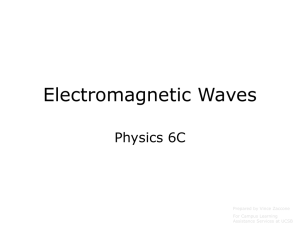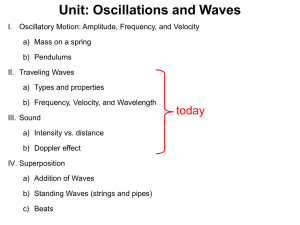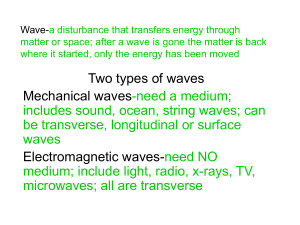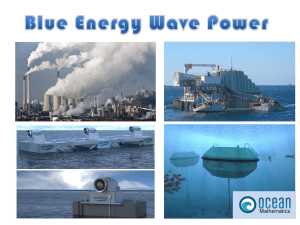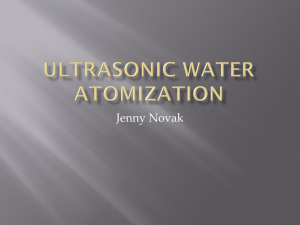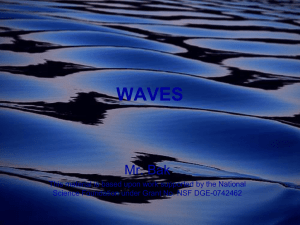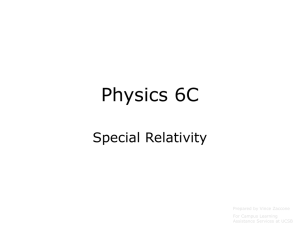22.1 Physics 6C EM Waves - UCSB Campus Learning Assistance
advertisement
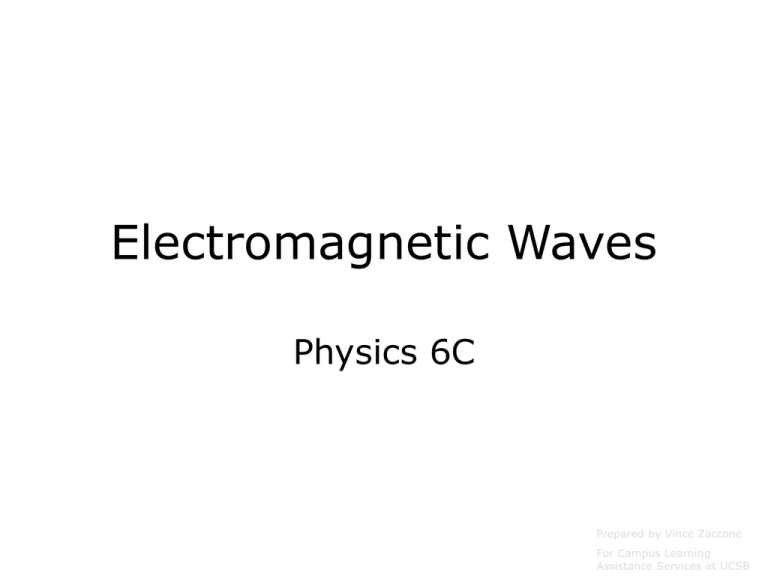
Electromagnetic Waves Physics 6C Prepared by Vince Zaccone For Campus Learning Assistance Services at UCSB Electromagnetic Waves Electromagnetic (EM) waves can be produced by atomic transitions (more on this later), or by an alternating current in a wire. As the charges in the wire oscillate back and forth, the electric field around them oscillates as well, in turn producing an oscillating magnetic field. This magnetic field is always perpendicular to the electric field, and the EM wave propagates perpendicular to both the E- and B-fields. This gives us a right-hand-rule relating the directions of these 3 vectors: 1) Point the fingers of your right hand in the direction of the E-field 2) Curl them toward the B-field. 3) Stick out your thumb - it points in the direction of propagation. Click here for an EM wave animation Prepared by Vince Zaccone For Campus Learning Assistance Services at UCSB Like any other wave, we know the relationship between the wavelength and frequency, and the speed of propagation of the wave: v wave f Prepared by Vince Zaccone For Campus Learning Assistance Services at UCSB Like any other wave, we know the relationship between the wavelength and frequency, and the speed of propagation of the wave: v wave f In the case of EM waves, it turns out that the wave speed is the speed of light. So our formula for EM waves (in vacuum) is: c f ; c 1 0 0 3 10 8 m s Prepared by Vince Zaccone For Campus Learning Assistance Services at UCSB Like any other wave, we know the relationship between the wavelength and frequency, and the speed of propagation of the wave: v wave f In the case of EM waves, it turns out that the wave speed is the speed of light. So our formula for EM waves (in vacuum) is: c f ; c 1 0 0 3 10 8 m s It turns out that the speed of light is also related to the strengths of the Electric and Magnetic fields. E=cB (in standard metric units) Prepared by Vince Zaccone For Campus Learning Assistance Services at UCSB Like any other wave, we know the relationship between the wavelength and frequency, and the speed of propagation of the wave: v wave f In the case of EM waves, it turns out that the wave speed is the speed of light. So our formula for EM waves (in vacuum) is: c f ; c 1 0 0 3 10 8 m s It turns out that the speed of light is also related to the strengths of the Electric and Magnetic fields. E=cB (in standard metric units) The continuum of various wavelengths and frequencies for EM waves is called the Electromagnetic Spectrum Prepared by Vince Zaccone For Campus Learning Assistance Services at UCSB Examples: • Find the frequency of blue light with a wavelength of 460 nm. Prepared by Vince Zaccone For Campus Learning Assistance Services at UCSB Examples: • Find the frequency of blue light with a wavelength of 460 nm. c f f c 3 10 8 m s 9 460 10 m 6 . 5 10 14 Hz Prepared by Vince Zaccone For Campus Learning Assistance Services at UCSB Examples: • Find the frequency of blue light with a wavelength of 460 nm. c f f c 3 10 8 m s 9 460 10 m 6 . 5 10 14 Hz • A cell phone transmits at a frequency of 1.25x108 Hz. What is the wavelength of this EM wave? Prepared by Vince Zaccone For Campus Learning Assistance Services at UCSB Examples: • Find the frequency of blue light with a wavelength of 460 nm. c f f c 3 10 8 m s 9 460 10 m 6 . 5 10 14 Hz • A cell phone transmits at a frequency of 1.25x108 Hz. What is the wavelength of this EM wave? c f c f 3 10 8 m s 8 1 . 25 10 Hz 2 .4m You will need to use this formula very often to convert back and forth between frequency and wavelength. Prepared by Vince Zaccone For Campus Learning Assistance Services at UCSB Energy and momentum in EM Waves Electromagnetic waves transport energy. The energy associated with a wave is stored in the oscillating electric and magnetic fields. We will find out later that the frequency of the wave determines the amount of energy that it carries. Since the EM wave is in 3-D, we need to measure the energy density (energy per unit volume). u avg 1 2 2 2 0 E 0 0 E rms 1 2 0 2 B0 1 0 2 B rms This is the energy per unit volume Note that the energy can be written in a few equivalent forms. Each can be useful, depending on the information you know about the wave. Prepared by Vince Zaccone For Campus Learning Assistance Services at UCSB Energy and momentum in EM Waves Electromagnetic waves transport energy. The energy associated with a wave is stored in the oscillating electric and magnetic fields. We will find out later that the frequency of the wave determines the amount of energy that it carries. Since the EM wave is in 3-D, we need to measure the energy density (energy per unit volume). u avg 1 2 2 2 0 E 0 0 E rms 1 2 0 2 B0 1 0 2 B rms This is the energy per unit volume Note that the energy can be written in a few equivalent forms. Each can be useful, depending on the information you know about the wave. We can also talk about the intensity of an EM wave (for light we would think of it as brightness). Just as for sound, intensity is measured as average power/area. S avg Power Area c u avg Just multiply the energy equation above by the speed of light to get the intensity. Prepared by Vince Zaccone For Campus Learning Assistance Services at UCSB Example: High-Energy Cancer Treatment Scientists are working on a technique to kill cancer cells by zapping them with ultrahighenergy pulses of light that last for an extremely short amount of time. These short pulses scramble the interior of a cell without causing it to explode, as long pulses do. We can model a typical such cell as a disk 5.0 µm in diameter, with the pulse lasting for 4.0 ns with an average power of 2.0x1012 W. We shall assume that the energy is spread uniformly over the faces of 100 cells for each pulse. a) How much energy is given to the cell during this pulse? b) What is the intensity (in W/m2) delivered to the cell? c) What are the maximum values of the electric and magnetic fields in the pulse? Prepared by Vince Zaccone For Campus Learning Assistance Services at UCSB Example: High-Energy Cancer Treatment Scientists are working on a technique to kill cancer cells by zapping them with ultrahighenergy pulses of light that last for an extremely short amount of time. These short pulses scramble the interior of a cell without causing it to explode, as long pulses do. We can model a typical such cell as a disk 5.0 µm in diameter, with the pulse lasting for 4.0 ns with an average power of 2.0x1012 W. We shall assume that the energy is spread uniformly over the faces of 100 cells for each pulse. a) How much energy is given to the cell during this pulse? b) What is the intensity (in W/m2) delivered to the cell? c) What are the maximum values of the electric and magnetic fields in the pulse? Recall that power is energy/time. So 2.0x1012 W is 2.0x1012 Joules/sec. Energy (2 . 0 10 12 J ) s ( 4 . 0 10 9 3 s ) 8 10 J 8000 J This is the total energy, which is spread out over 100 cells, so the energy for each individual cell is 80 Joules. Prepared by Vince Zaccone For Campus Learning Assistance Services at UCSB Example: High-Energy Cancer Treatment Scientists are working on a technique to kill cancer cells by zapping them with ultrahighenergy pulses of light that last for an extremely short amount of time. These short pulses scramble the interior of a cell without causing it to explode, as long pulses do. We can model a typical such cell as a disk 5.0 µm in diameter, with the pulse lasting for 4.0 ns with an average power of 2.0x1012 W. We shall assume that the energy is spread uniformly over the faces of 100 cells for each pulse. a) How much energy is given to the cell during this pulse? b) What is the intensity (in W/m2) delivered to the cell? c) What are the maximum values of the electric and magnetic fields in the pulse? To get intensity, we need to divide power/area. The area for a cell is just the area of a circle: Area r 2 (2 . 5 10 6 2 m) 2 . 0 10 11 m 2 Prepared by Vince Zaccone For Campus Learning Assistance Services at UCSB Example: High-Energy Cancer Treatment Scientists are working on a technique to kill cancer cells by zapping them with ultrahighenergy pulses of light that last for an extremely short amount of time. These short pulses scramble the interior of a cell without causing it to explode, as long pulses do. We can model a typical such cell as a disk 5.0 µm in diameter, with the pulse lasting for 4.0 ns with an average power of 2.0x1012 W. We shall assume that the energy is spread uniformly over the faces of 100 cells for each pulse. a) How much energy is given to the cell during this pulse? b) What is the intensity (in W/m2) delivered to the cell? c) What are the maximum values of the electric and magnetic fields in the pulse? To get intensity, we need to divide power/area. The area for a cell is just the area of a circle: Area r 2 (2 . 5 10 6 2 m) 2 . 0 10 11 m 2 Now divide to get intensity: Intensity Power 100 r This is the total area of all 100 cells. 2 2 . 0 10 2 . 0 10 12 9 W m 2 1 . 0 10 21 W m 2 Prepared by Vince Zaccone For Campus Learning Assistance Services at UCSB Example: High-Energy Cancer Treatment Scientists are working on a technique to kill cancer cells by zapping them with ultrahighenergy pulses of light that last for an extremely short amount of time. These short pulses scramble the interior of a cell without causing it to explode, as long pulses do. We can model a typical such cell as a disk 5.0 µm in diameter, with the pulse lasting for 4.0 ns with an average power of 2.0x1012 W. We shall assume that the energy is spread uniformly over the faces of 100 cells for each pulse. a) How much energy is given to the cell during this pulse? b) What is the intensity (in W/m2) delivered to the cell? c) What are the maximum values of the electric and magnetic fields in the pulse? To get the field strengths, recall our formulas: u avg 1 2 2 2 0 E 0 0 E rms 1 2 0 2 B0 1 0 2 B rms S avg Power Area c u avg Prepared by Vince Zaccone For Campus Learning Assistance Services at UCSB Example: High-Energy Cancer Treatment Scientists are working on a technique to kill cancer cells by zapping them with ultrahighenergy pulses of light that last for an extremely short amount of time. These short pulses scramble the interior of a cell without causing it to explode, as long pulses do. We can model a typical such cell as a disk 5.0 µm in diameter, with the pulse lasting for 4.0 ns with an average power of 2.0x1012 W. We shall assume that the energy is spread uniformly over the faces of 100 cells for each pulse. a) How much energy is given to the cell during this pulse? b) What is the intensity (in W/m2) delivered to the cell? c) What are the maximum values of the electric and magnetic fields in the pulse? To get the field strengths, recall our formulas: u avg 1 2 2 2 0 E 0 0 E rms Since the power was stated as average power we should assume that is the rms value. So our field values should get multiplied by √2 to find the maximum. 1 2 0 2 B0 E0 B0 1 0 2 B rms 2S c 0 8 . 7 10 20 S c S avg 11 Power Area c u avg V m 3 2 . 9 10 T Prepared by Vince Zaccone For Campus Learning Assistance Services at UCSB Photons The energy carried by an EM wave comes in packets called photons. The energy of a photon depends on the frequency of the EM wave. E photon hf The constant h is called Planck’s constant. ℎ ≈ 6.626 𝑥 10−34 𝐽 ∙ 𝑠 Notice that this is an incredibly small number. Prepared by Vince Zaccone For Campus Learning Assistance Services at UCSB Photons The energy carried by an EM wave comes in packets called photons. The energy of a photon depends on the frequency of the EM wave. E photon hf hc The constant h is called Planck’s constant. ℎ ≈ 6.626 𝑥 10−34 𝐽 ∙ 𝑠 Notice that this is an incredibly small number. Because photon energies are usually so small, it is often convenient to express their energy in units of electron-volts (eV) instead of Joules. Recall the conversion factor: 1 eV = 1.6x10-19 J Prepared by Vince Zaccone For Campus Learning Assistance Services at UCSB Photons The energy carried by an EM wave comes in packets called photons. The energy of a photon depends on the frequency of the EM wave. E photon hf hc The constant h is called Planck’s constant. ℎ ≈ 6.626 𝑥 10−34 𝐽 ∙ 𝑠 Notice that this is an incredibly small number. Because photon energies are usually so small, it is often convenient to express their energy in units of electron-volts (eV) instead of Joules. Recall the conversion factor: 1 eV = 1.6x10-19 J For convenience, Planck’s constant can be converted to eV instead of Joules: ℎ ≈ 4.14 𝑥 10−15 𝑒𝑉 ∙ 𝑠 This will be useful when dealing with photon energies. Prepared by Vince Zaccone For Campus Learning Assistance Services at UCSB Photons Example: A typical x-ray machine scans the body with EM waves of frequency 7x1018Hz. How much energy is in a typical x-ray photon? Prepared by Vince Zaccone For Campus Learning Assistance Services at UCSB Photons Example: A typical x-ray machine scans the body with EM waves of frequency 7x1018Hz. How much energy is in a typical x-ray photon? We can give the answer in Joules or eV: E photon hf E photon ( 6 . 626 10 E photon ( 4 . 14 10 34 15 J s )( 7 10 18 eV s )( 7 10 18 Hz ) 4 . 64 10 15 J Hz ) 29 ,000 eV 29 keV Prepared by Vince Zaccone For Campus Learning Assistance Services at UCSB Energy and momentum in EM Waves EM waves also carry momentum. This means that a ray of light can actually exert a force. To get the pressure exerted by a sinusoidal EM wave, just divide the intensity by the speed of light. Radiation Pr essure S avg This is the same as the total energy absorbed by the surface. c Prepared by Vince Zaccone For Campus Learning Assistance Services at UCSB Energy and momentum in EM Waves EM waves also carry momentum. This means that a ray of light can actually exert a force. To get the pressure exerted by a sinusoidal EM wave, just divide the intensity by the speed of light. Radiation Pr essure S avg c Example: Solar Sails Suppose a spacecraft with a mass of 25,000 kg has a solar sail made of perfectly reflective aluminized film with an area of 2.59x106 m. If the spacecraft is launched into earth orbit and then deploys its sail at right angles to the sunlight, what is the acceleration due to sunlight? Assume that at the earth’s distance from the sun, the pressure exerted by sunlight on an absorbing surface is 4.70x10-6 Pa. Prepared by Vince Zaccone For Campus Learning Assistance Services at UCSB Example: Solar Sails Suppose a spacecraft with a mass of 25,000 kg has a solar sail made of perfectly reflective aluminized film with an area of 2.59x106 m. If the spacecraft is launched into earth orbit and then deploys its sail at right angles to the sunlight, what is the acceleration due to sunlight? Assume that at the earth’s distance from the sun, the pressure exerted by sunlight on an absorbing surface is 4.70x10-6 Pa. Recall that Pressure = Force/Area. We can use this and F=ma to get our formula: P F A F PA F m a a F a P A m m Now for the tricky part: When the pressure number was given above, that was for an absorbing surface. What happens when the sunlight reflects instead? Prepared by Vince Zaccone For Campus Learning Assistance Services at UCSB Example: Solar Sails Suppose a spacecraft with a mass of 25,000 kg has a solar sail made of perfectly reflective aluminized film with an area of 2.59x106 m. If the spacecraft is launched into earth orbit and then deploys its sail at right angles to the sunlight, what is the acceleration due to sunlight? Assume that at the earth’s distance from the sun, the pressure exerted by sunlight on an absorbing surface is 4.70x10-6 Pa. Recall that Pressure = Force/Area. We can use this and F=ma to get our formula: P F A F PA F m a a a F P A m m Now for the tricky part: When the pressure number was given above, that was for an absorbing surface. What happens when the sunlight reflects instead? Twice as much momentum is transferred! a 2 ( 4 . 7 10 6 6 N m ) 2 . 59 10 m 2 4 2 . 5 10 kg 2 9 . 72 10 4 m s 2 Prepared by Vince Zaccone For Campus Learning Assistance Services at UCSB
